Packaged Droplet Microresonator for Thermal Sensing with High Sensitivity
Abstract
:1. Introduction
2. Theoretical Analysis
3. Experimental Setups
4. Measurement and Analysis
4.1. Lasing Characteristics and Stability Analysis in Packaged MBR
4.2. Packaged Quasi-Droplet MBR
4.3. Packaged Droplet WGM Resonator
5. Conclusions
Author Contributions
Funding
Conflicts of Interest
References
- Vahala, K.J. Optical microcavities. Nature 2003, 424, 839–846. [Google Scholar] [CrossRef] [PubMed]
- Slusher, R.E. Optical processes in microcavities. Phys. Today 1993, 46, 66–73. [Google Scholar] [CrossRef]
- He, L.; Ouml, Ş.K.; Yang, L. Whispering gallery microcavity lasers. Laser Photonics Rev. 2013, 7, 60–82. [Google Scholar] [CrossRef]
- Lee, W.; Sun, Y.; Li, H.; Reddy, K.; Sumetsky, M.; Fan, X. A quasi-droplet optofluidic ring resonator laser using a micro-bubble. Appl. Phys. Lett. 2011, 99, 091002. [Google Scholar] [CrossRef]
- Spillane, S.M.; Kippenberg, T.J.; Vahala, K.J. Ultralow-threshold Raman laser using a spherical dielectric microcavity. Nature 2002, 415, 621–623. [Google Scholar] [CrossRef] [PubMed] [Green Version]
- Cohoon, G.A.; Kieu, K.; Norwood, R.A. Observation of two-photon fluorescence for Rhodamine 6G in microbubble resonators. Opt. Lett. 2014, 39, 3098–3101. [Google Scholar] [CrossRef] [PubMed]
- Rabiei, P.; Steier, W.H. Tunable polymer double micro-ring filters. Photonics Tech. Lett. IEEE 2003, 15, 1255–1257. [Google Scholar] [CrossRef]
- Xiao, S.; Khan, M.H.; Shen, H.; Qi, M. A highly compact third-order silicon microring add-drop filter with a very large free spectral range, a flat passband and a low delay dispersion. Opt. Express 2007, 15, 14765–14771. [Google Scholar] [CrossRef] [PubMed]
- Armani, A.M.; Kulkarni, R.P.; Fraser, S.E.; Flagan, R.C.; Vahala, K.J. Label-free, single-molecule detection with optical microcavities. Science 2007, 317, 783–787. [Google Scholar] [CrossRef] [PubMed]
- Vollmer, F.; Arnold, S. Whispering-gallery-mode biosensing: Label-free detection down to single molecules. Nat. Methods 2008, 5, 591–596. [Google Scholar] [CrossRef] [PubMed]
- He, L.; Ozdemir, S.K.; Zhu, J.; Kim, W.; Yang, L. Detecting single viruses and nanoparticles using whispering gallery microlasers. Nat. Nanotechnol. 2011, 6, 428–432. [Google Scholar] [CrossRef] [PubMed] [Green Version]
- Santiagocordoba, M.A.; Boriskina, S.V.; Vollmer, F.; Demirel, M.C. Nanoparticle-based protein detection by optical shift of a resonant microcavity. Appl. Phys. Lett. 2011, 99, 073701. [Google Scholar] [CrossRef]
- Ward, J.; Benson, O. WGM microresonators: Sensing, lasing and fundamental optics with microspheres. Laser Photonics Rev. 2011, 5, 553–570. [Google Scholar] [CrossRef]
- Liu, Y.; Davanço, M.; Aksyuk, V.; Srinivasan, K. Electromagnetically induced transparency and wideband wavelength conversion in silicon nitride microdisk optomechanical resonators. Phys. Rev. Lett 2013, 110, 223603–223607. [Google Scholar] [CrossRef] [PubMed]
- Watkins, A.; Ward, J.; Wu, Y.; Chormaic, S.N. Single-input spherical microbubble resonator. Opt. Lett. 2011, 36, 2113–2115. [Google Scholar] [CrossRef] [PubMed]
- Bogaerts, W.; De Heyn, P.; Van Vaerenbergh, T.; De Vos, K.; Kumar Selvaraja, S.; Claes, T.; Dumon, P.; Bienstman, P.; Van Thourhout, D.; Baets, R. Silicon microring resonators. Laser Photonics Rev. 2015, 6, 47–73. [Google Scholar] [CrossRef]
- Zhang, C.L.; Gong, Y.; Zou, W.L.; Wu, Y.; Rao, Y.J.; Peng, G.D.; Fan, X. Microbubble-Based Fiber Optofluidic Interferometer for Sensing. J. Lightwave Technol. 2017, 35, 2514–2519. [Google Scholar] [CrossRef]
- Ta, V.D.; Chen, R.; Ma, L.; Ying, Y.J.; Sun, H.D. Whispering gallery mode microlasers and refractive index sensing based on single polymer fiber. Laser Photonics Rev. 2013, 7, 133–139. [Google Scholar]
- Ashkin, A.; Dziedzic, J.M. Observation of Resonances in the Radiation Pressure on Dielectric Spheres. Phys. Rev. Lett. 1977, 38, 1351–1354. [Google Scholar] [CrossRef]
- Lin, H.; Eversole, J.D.; Campillo, A.J. Spectral properties of lasing microdroplets. J. Opt. Soc. Am. B 1992, 9, 43–50. [Google Scholar] [CrossRef]
- Avino, S.; Krause, A.; Zullo, R.; Giorgini, A.; Malara, P.; De Natale, P.; Loock, H.P.; Gagliardi, G. Direct Sensing in Liquids Using Whispering-Gallery-Mode Droplet Resonators. Adv. Opt. Mater. 2015, 2, 1155–1159. [Google Scholar] [CrossRef]
- Jonáš, A.; Kiraz, A.; Mestre, M.; Karadag, Y. Probing of ultrahigh optical Q-factors of individual liquid microdroplets on superhydrophobic surfaces using tapered optical fiber waveguides. J. Opt. Soc. Am. B 2012, 29, 3240–3247. [Google Scholar] [CrossRef]
- Labrador-Páez, L.; Soler-Carracedo, K.; Hernández-Rodríguez, M.; Martín, I.R.; Carmon, T.; Martin, L.L. Liquid whispering-gallery-mode resonator as a humidity sensor. Opt. Express 2017, 25, 1165–1172. [Google Scholar] [CrossRef] [PubMed]
- Liu, Z.; Liu, L.; Zhu, Z.; Zhang, Y.; Wei, Y.; Zhang, X.; Zhao, E.; Zhang, Y.; Yang, J.; Yuan, L. Whispering gallery mode temperature sensor of liquid microresonastor. Opt. Lett. 2016, 41, 4649–4652. [Google Scholar] [CrossRef] [PubMed]
- Liu, S.; Shi, B.; Wang, Y.; Cui, L.; Yang, J.; Sun, W.; Li, H. Whispering gallery modes in a liquid-filled hollow glass microsphere. Opt. Lett. 2017, 42, 4659–4662. [Google Scholar] [CrossRef] [PubMed]
- Wang, Y.; Li, H.; Zhao, L.; Liu, Y.; Liu, S.; Yang, J. Tunable whispering gallery modes lasing in dye-doped cholesteric liquid crystal microdroplets. Appl. Phys. Lett. 2016, 109, 231906. [Google Scholar] [CrossRef]
- Vahala, K.J.; Hosseinzadeh, M. Fiber-taper coupling to Whispering-Gallery modes of fluidic resonators embedded in a liquid medium. Opt. Express 2006, 14, 10800–10810. [Google Scholar]
- Wang, Y.; Li, H.; Zhao, L.; Liu, Y.; Liu, S.; Yang, J. Tapered optical fiber waveguide coupling to whispering gallery modes of liquid crystal microdroplet for thermal sensing application. Opt. Express 2017, 25, 918–926. [Google Scholar] [CrossRef] [PubMed]
- Zhang, H.; Balram, A.; Meng, D.D.; Sun, Y. Optofluidic Lasers with Monolayer Gain at the Liquid–Liquid Interface. ACS Photonics 2017, 4, 621–625. [Google Scholar] [CrossRef]
- Yang, Y.; Ward, J.; Chormaic, S.N. Quasi-droplet Microbubbles for High Resolution Sensing Applications. Opt. Express 2014, 22, 6881–6898. [Google Scholar] [CrossRef] [PubMed]
- Ward, J.M.; Yang, Y.; Lei, F.; Yu, X.-C.; Xiao, Y.-F.; Chormaic, S.N. Nanoparticle sensing beyond evanescent field interaction with a quasi-droplet microcavity. Optica 2018, 5, 674–677. [Google Scholar] [CrossRef]
- Bohren, C.F.; Huffman, D.R. Absorption and Scattering of Light by Small Particles. Opt. Laser Technol. 1998, 31, 328. [Google Scholar]
- Sun, Y.; Fan, X. Analysis of ring resonators for chemical vapor sensor development. Opt. Express 2008, 16, 10254–10268. [Google Scholar] [CrossRef] [PubMed]
- Kaplan, S.G.; Burnett, J.H. Optical properties of fluids for 248 and 193 nm immersion photolithography. Appl. Opt. 2006, 45, 1721–1724. [Google Scholar] [CrossRef] [PubMed]
- He, L.; Xiao, Y.F.; Zhu, J.; Ozdemir, S.K.; Yang, L. Oscillatory thermal dynamics in high-Q PDMS-coated silica toroidal microresonators. Opt. Express 2009, 17, 9571–9581. [Google Scholar] [CrossRef] [PubMed]
- Teraoka, I.; Arnold, S. Coupled whispering gallery modes in a multilayer-coated microsphere. Opt. Lett. 2007, 32, 1147–1149. [Google Scholar] [CrossRef] [PubMed]
- White, I.M.; Gohring, J.; Sun, Y.; Yang, G.; Lacey, S.; Fan, X. Versatile waveguide-coupled optofluidic devices based on liquid core optical ring resonators. Appl. Phys. Lett. 2007, 91, 241104. [Google Scholar] [CrossRef] [PubMed]
- Martín, L.L.; Pérezrodríguez, C.; Harogonzález, P.; Martín, I.R. Whispering gallery modes in a glass microsphere as a function of temperature. Opt. Express 2011, 19, 25792–25798. [Google Scholar] [CrossRef] [PubMed]
- Zhang, C.; Cocking, A.; Freeman, E.; Liu, Z.; Tadigadapa, S. Whispering gallery mode based on-chip glass microbubble resonator for thermal sensing. In Proceedings of the International Conference on Solid-State Sensors, Actuators and Microsystems, Kaohsiung, Taiwan, 18–22 June 2017; pp. 630–633. [Google Scholar]
- Li, M.; Wu, X.; Liu, L.; Xu, L. Kerr parametric oscillations and frequency comb generation from dispersion compensated silica micro-bubble resonators. Opt. Express 2013, 21, 16908–16913. [Google Scholar] [CrossRef] [PubMed]
- François, A.; Riesen, N.; Gardner, K.; Monro, T.M.; Meldrum, A. Lasing of whispering gallery modes in optofluidic microcapillaries. Opt. Express 2016, 24, 12466–12477. [Google Scholar] [CrossRef] [PubMed]
- Reynolds, T.; Riesen, N.; Meldrum, A.; Fan, X.; Hall, J.M.M.; Monro, T.M.; François, A. Fluorescent and lasing whispering gallery mode microresonators for sensing applications. Laser Photonics Rev. 2017, 11, 1600265. [Google Scholar] [CrossRef]
- Ward, J.M.; Yang, Y.; Chormaic, S.N. Highly Sensitive Temperature Measurements with Liquid-Core Microbubble Resonators. IEEE Photonics Technol. Lett. 2013, 25, 2350–2353. [Google Scholar] [CrossRef]
- Yu, J.; Lewis, E.; Brambilla, G.; Wang, P. Temperature Sensing Performance of Microsphere Resonators. Sensors 2018, 18, 2515. [Google Scholar] [CrossRef] [PubMed]
- Nawrocka, M.S.; Liu, T.; Wang, X.; Panepucci, R.R. Tunable silicon microring resonator with wide free spectral range. Appl. Phys. Lett. 2006, 89, 071110. [Google Scholar] [CrossRef]
- Özel, B.; Nett, R.; Weigel, T.; Schweiger, G.; Ostendorf, A. Temperature sensing by using whispering gallery modes with hollow core fibers. Meas. Sci. Technol. 2010, 21, 094015. [Google Scholar] [CrossRef]
- Jordan, A.M.; Viswanath, V.; Kim, S.E.; Pokorski, J.K.; Korley, L.S.T.J. Processing and surface modification of polymer nanofibers for biological scaffolds: A review. J. Mater. Chem. B 2016, 4, 5958–5974. [Google Scholar] [CrossRef]
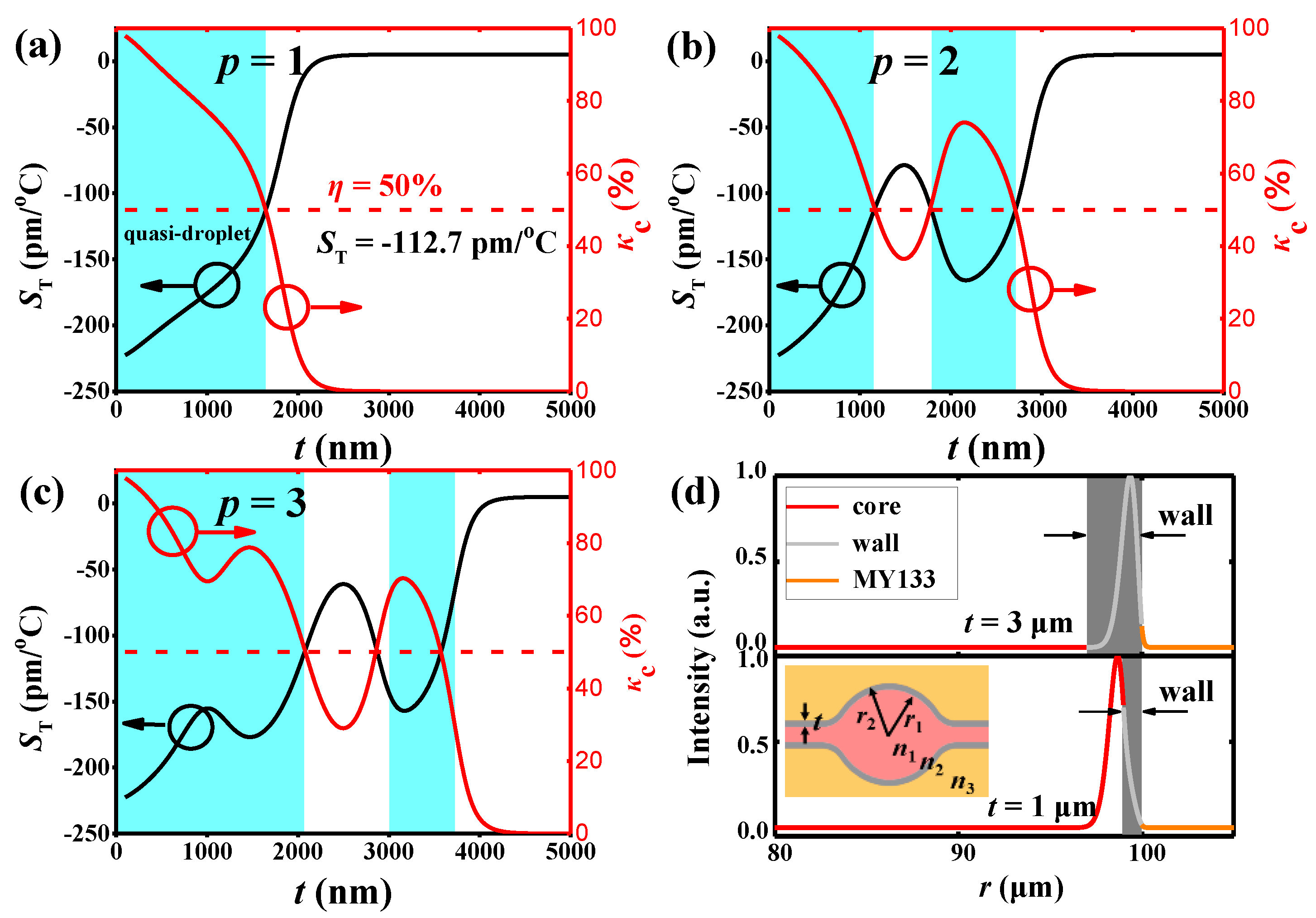


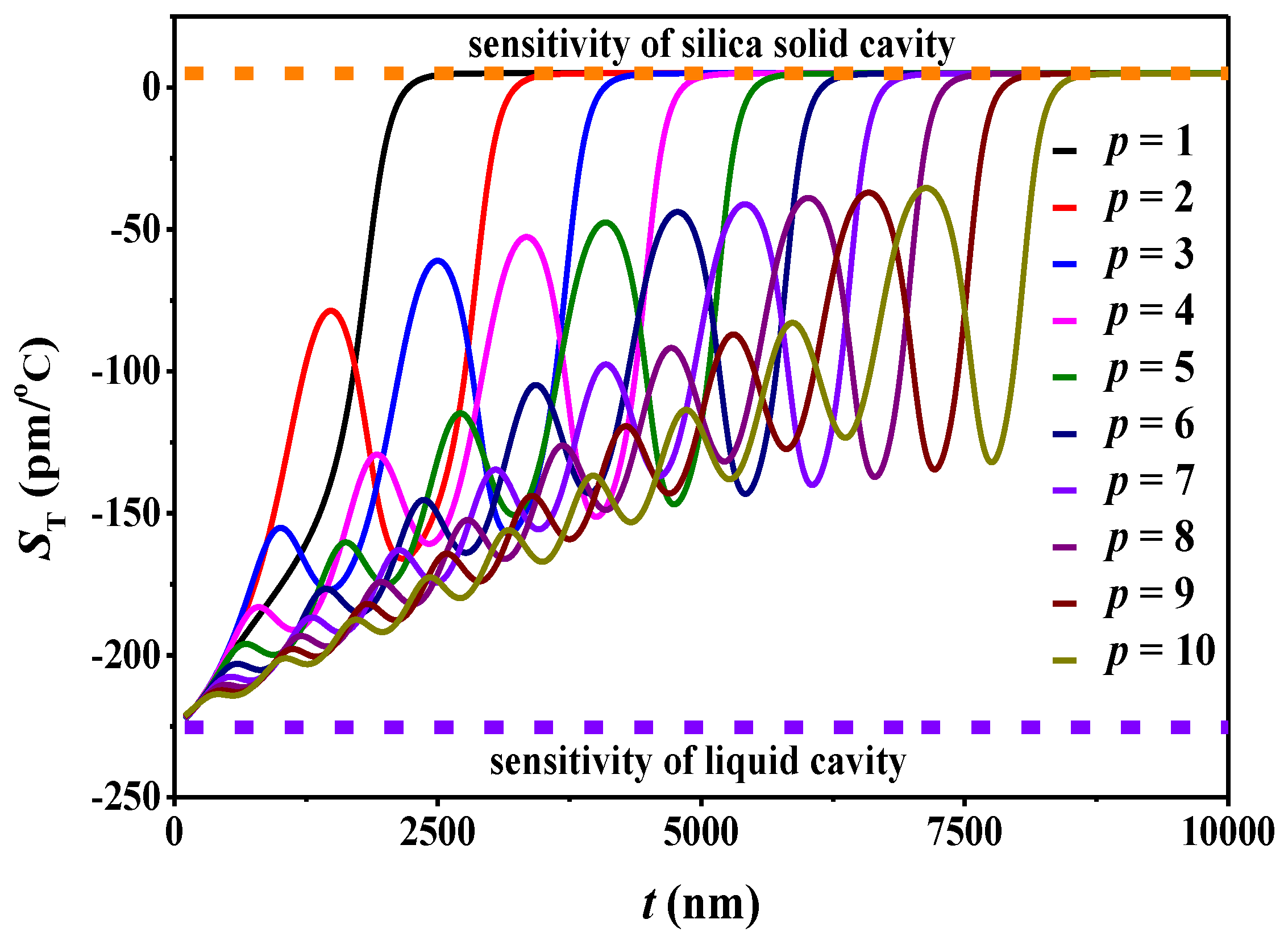


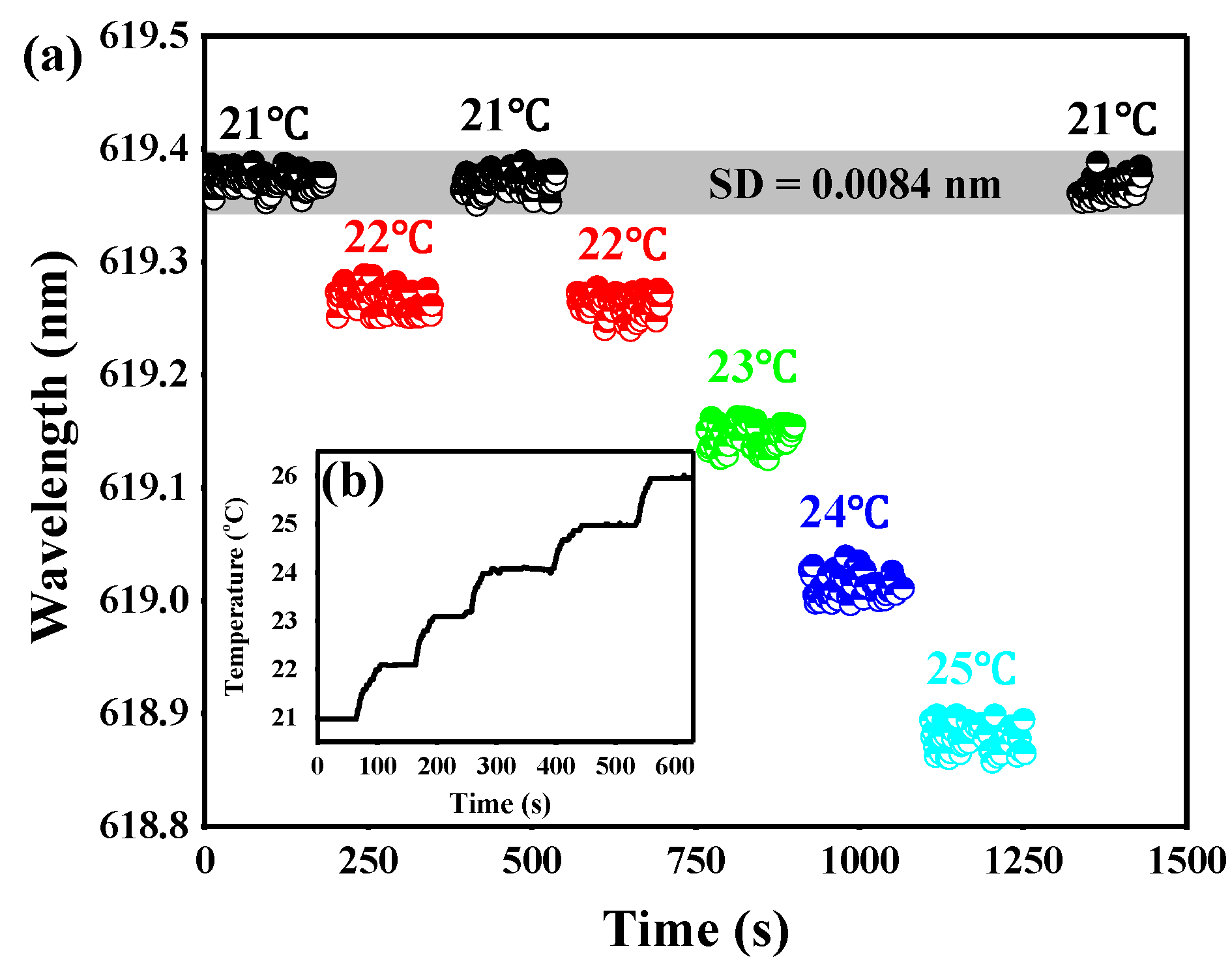
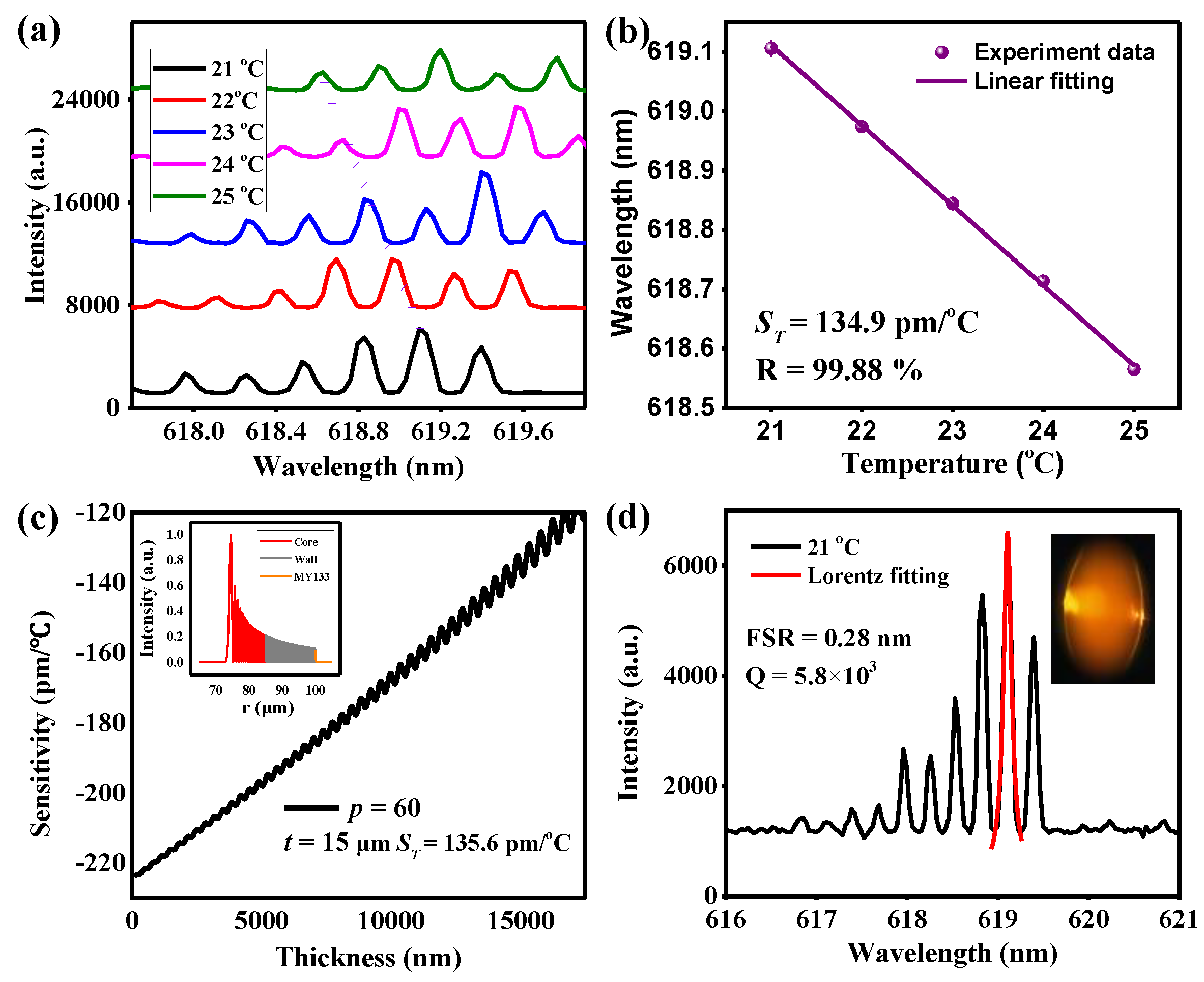

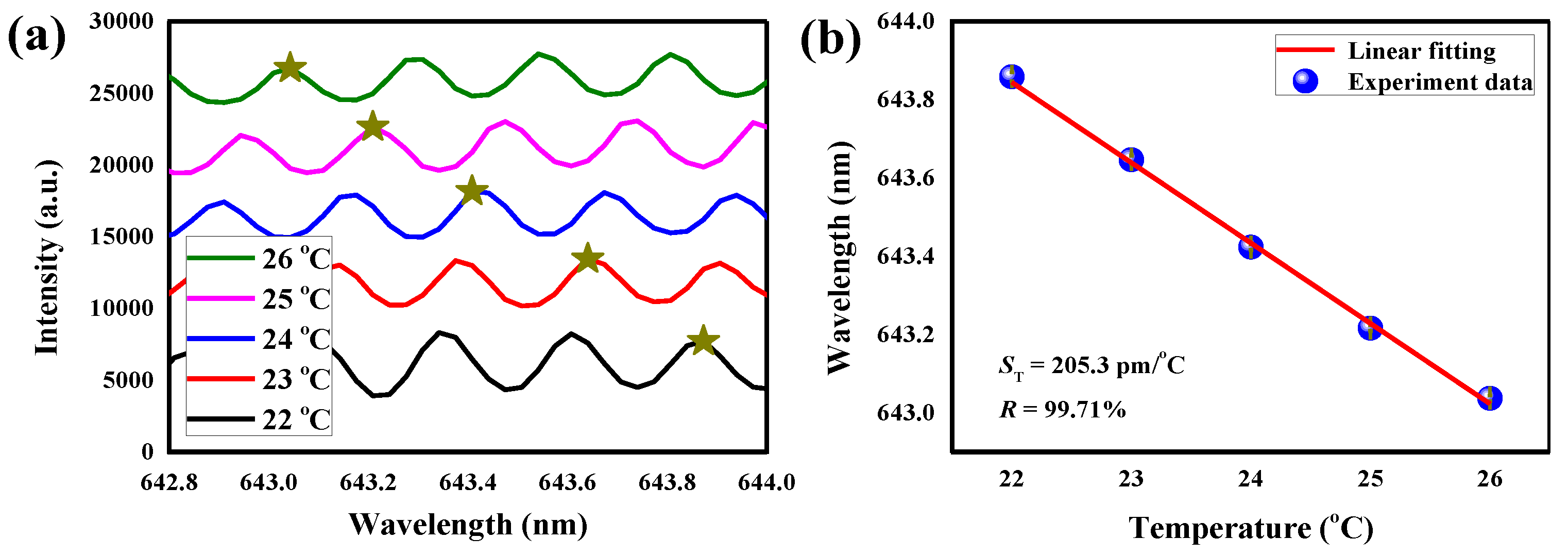
© 2018 by the authors. Licensee MDPI, Basel, Switzerland. This article is an open access article distributed under the terms and conditions of the Creative Commons Attribution (CC BY) license (http://creativecommons.org/licenses/by/4.0/).
Share and Cite
Chen, X.; Fu, L.; Lu, Q.; Wu, X.; Xie, S. Packaged Droplet Microresonator for Thermal Sensing with High Sensitivity. Sensors 2018, 18, 3881. https://doi.org/10.3390/s18113881
Chen X, Fu L, Lu Q, Wu X, Xie S. Packaged Droplet Microresonator for Thermal Sensing with High Sensitivity. Sensors. 2018; 18(11):3881. https://doi.org/10.3390/s18113881
Chicago/Turabian StyleChen, Xiaogang, Liang Fu, Qijing Lu, Xiang Wu, and Shusen Xie. 2018. "Packaged Droplet Microresonator for Thermal Sensing with High Sensitivity" Sensors 18, no. 11: 3881. https://doi.org/10.3390/s18113881




